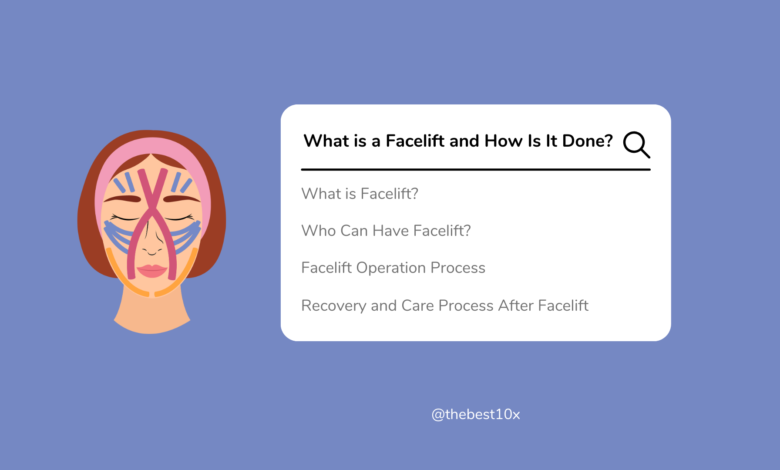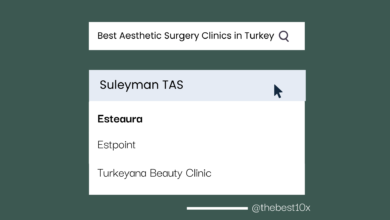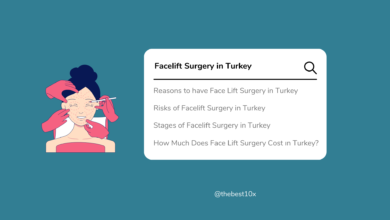
What is a Facelift and How Is It Done?
Popular in the aesthetic world, facelift is a surgical procedure that alleviates the effects of aging and reduces signs such as sagging and wrinkles on the face. This regenerative operation allows the facial skin to tighten and facial contours to gain a younger, fresher appearance. Facelift surgery usually involves tightening the skin, repositioning the underlying tissues and removing fatty tissue when necessary. In this article, we will explore what facelift is, how it is done and the potential advantages of this aesthetic procedure. This information on the rejuvenation process of the face will provide a comprehensive starting point for those considering facelift or those who want to learn about plastic surgery.
What Is Facelift?
Facelift (facelift surgery) is a frequently preferred surgery in the field of aesthetic surgery and is a procedure performed to remove signs of aging and achieve a youthful appearance. This surgery usually involves repositioning the tissues under the skin, especially the SMAS layer (superficial musculoaponeurotic system) and excess skin tissue. Sagging skin on the face is tightened, deep wrinkles and lines are reduced, facial contours are rejuvenated. The surgery is usually performed under general anesthesia and different techniques can be applied depending on the surgeon’s preference. Although the recovery process varies from individual to individual, patients can usually return to their daily activities within a few weeks. Facelift is a procedure that should be planned in accordance with the experience of the plastic surgeon and the needs of the patient, it is important to achieve a healthy healing process and natural-looking results.
What Are The Objectives Of Facelift Surgery?
The main purpose of facelift surgery is to reduce, tighten and rejuvenate the signs of aging in the facial area. This surgery is designed to achieve a number of aesthetic goals. Here are the main objectives of the facelift:
- Skin Tightening: Facelift is performed to tighten and tighten sagging skin on the face. With the aging process, the skin loses its elasticity, so the facelift aims to give the skin a young, fresh and firm appearance.
- Reducing Deep Wrinkles: Deep wrinkles and lines on the face can become evident over time. Facelift aims to provide smoother skin by reducing deep wrinkles, especially around the eyes, forehead and mouth.
- Redefining Facial Features: The surgery aims to define facial features in a more prominent and youthful way. Especially the jaw line, cheek area and neck contours are reshaped.
- Correction of Sagging Skin in the Lower Chin and Neck: Facelift aims to achieve a firmer and younger appearance by lifting the sagging skin in the lower chin and neck.
- Natural and Harmonious Appearance: One of the main goals of the surgery is to provide a natural and harmonious rejuvenation of the patient’s face. It is important that the surgical intervention is not obvious and the patient’s facial expression is preserved.
- Authenticity Preservation: Facelift aims to provide a personalized rejuvenation while preserving the patient’s facial structure and uniqueness. Surgical planning is tailored to the needs of each patient.
Facelift surgery should be performed in a personalized way, taking into account the experience of the plastic surgeon and the patient’s expectations. This surgery aims to give patients a youthful and fresh appearance by effectively removing the signs of aging.
Who Can Have Facelift?
Facelift surgery is generally suitable for individuals of certain ages and skin conditions. However, it is not the same for everyone and a number of factors should be considered when deciding on this type of plastic surgery intervention. The general criteria for who can have facelift are as follows:
| Status / Criteria | Eligible Candidates | Ineligible Candidates |
| Aesthetic Concerns | – People who are dissatisfied with their facial appearance | – People experiencing postoperative uncertainty or unsure of their desire for change |
| – Individuals who want to correct sagging and wrinkles on the face | ||
| Functional Problems | – Individuals who do not have problems with facial functions | – Those with serious chronic health conditions |
| – Pregnant or lactating women | ||
| Trauma or Injuries | – People with facial deformation as a result of trauma | – People with chronic infections |
| Age Factor | – People with complete facial development | – Children with incomplete facial development |
| Health Status | – Those who do not have a health condition that may prevent surgery | – Those who have blood clotting problems, those who use blood thinners |
| – Heart and high blood pressure patients | ||
| Realistic Expectations | – Those who expect realistic results from surgery | – Those who expect surreal results from the surgery should think again as they may be unhappy afterwards. |
| Psychological Preparation | – Psychologically prepared for surgery and postoperative period | – Those who have not prepared their psychology for the operation, those who are undergoing psychological treatment. |
Facelift Operation Process
Facelift operation is a process consisting of a series of steps:
- Consultation and Evaluation:
In the Consultation and Assessment phase, the patient’s expectations for surgery are determined and the surgeon assesses specific areas on the face. This helps to plan the surgery according to the individual’s specific needs.
- Surgery Planning:
In the Surgery Planning phase, the surgeon plans the details of the surgery based on the expectations set. At this stage, the techniques to be used, the duration of surgery and the healing process are determined. The patient is informed about how they will look after surgery.
- Surgery Day
On the day of surgery, it usually takes place under general anesthesia. The surgeon carefully lifts the sagging skin on the face and repositions the tissues underneath to achieve a more youthful appearance. If necessary, facial volume loss is also corrected using fat transfer or fillers.
- Recovery Process
The Recovery Process is important to ensure that patients have a comfortable recovery after surgery. After several days of observation, patients are given specific wound care instructions and restrictions.
- Control and Support
During the Control and Support phase, the surgeon monitors the healing process of the patients with regular check-ups. It provides the necessary support to prevent possible complications in the postoperative period and to ensure the health of patients.
Facelift operation is an effective aesthetic surgery method that provides the patient with a rejuvenated and natural appearance. When well planned and performed by an experienced surgeon, it is possible to achieve successful results.
Facelift Types And Usage Areas
Facelift is a plastic surgery procedure to correct sagging and wrinkles on the face. The types and uses of this operation may vary depending on the needs of the person and the signs of aging. Here is an overview of facelift types and usage areas:
- Classic (Traditional) Facelift:
- It is the most common type of facelift applied to correct general sagging and wrinkles on the face.
- It aims to tighten the skin on the neck, chin and cheeks.
- SMAS Facelift:
- It is a more comprehensive surgical method that includes the superficial muscle and skin layer on the face.
- Effective for firming the mid-face area and neck.
- Mini Facelift:
- It is a less invasive option and is generally preferred among middle-aged and younger individuals.
- It offers a faster healing process by focusing only on specific facial areas.
- Non-Surgical Facelift:
- It is an option to reduce facial sagging with non-surgical techniques, for example using dermal fillers or botox injections.
- Surgery minimizes the risks, but the effects can often be shorter lasting.
- Golden Needle Facelift:
- It is a technique using gold needles.
- Specially designed gold needles are used to tighten and rejuvenate the skin.
- Deep (Deep) Plane Facelift:
- SMAS is similar to Facelift but focuses on deeper tissues.
- It is generally suitable for people with more pronounced signs of sagging and aging.
Recovery And Care Process After Facelift
The recovery process after facelift operation may vary depending on the general health status of the person, the extent of the surgery and the techniques used. However, in general, the recovery and care process after facelift consists of the following stages:
- First Postoperative Days:
- Patients are usually kept under observation for a few hours in the first postoperative days.
- Swelling and bruising on the face is normal and a bandage with head and neck support can be used during this process.
- If necessary, the surgeon may prescribe prescription medication for pain management.
- First Week
- During the first week, patients should take care to rest and maintain the lying position.
- Bandages and stitches must be maintained for a certain period of time.
- The swelling and bruising on the skin starts to decrease, but full recovery may take several weeks.
- First Month
- Physical activities should be limited in the first month.
- The surgeon may recommend ice applications and certain exercises to reduce facial swelling.
- Avoid the sun and use sunscreen to protect against solar radiation.
- First Six Months:
- Within the first six months, facial swelling and bruising are greatly reduced.
- The surgeon can make suggestions to make the patient’s facial expression natural.
- Follow-up appointments and other follow-up processes recommended by the surgeon should be performed regularly.
- Long Term Care:
- Long-term care after facelift surgery includes maintaining a healthy lifestyle.
- Factors such as a healthy diet, regular exercise and not smoking can affect the long-term results of the operation.
- The surgeon can recommend appropriate skin care products and procedures for the patient.
The recovery process after facelift varies depending on the individual and how well they follow the surgeon’s instructions. The healing process can be an individual experience for everyone, so it is important to strictly follow the surgeon’s recommendations.
Frequently Asked Questions
What is the technique used during facelift surgery?
Answer: The classic facelift is a surgical procedure in which the skin is usually lifted and the underlying tissues are reshaped. Different techniques can include SMAS facelift, mini facelift and deep plane facelift.
What is the duration of the surgery?
Answer: The duration of the facelift operation usually ranges from 2 to 4 hours, but this time may vary depending on the techniques used and the extent of the operation.
How soon can I return to my normal life after facelift?
Patients can usually return to social activities within a week after surgery. Full recovery may take several weeks.
Is facelift a painful operation?
Pain is usually managed with painkillers prescribed by the surgeon and patients have a comfortable recovery.
How long do the results last after facelift?
Facelift results vary from person to person, but generally offer long-term results. However, as the aging process continues, signs of natural aging may appear over time.
Since facelift surgery is a comprehensive aesthetic intervention that changes the distinctive features of your face, the choice of surgeon is of critical importance. Choosing the right surgeon plays a vital role in achieving the aesthetic results you want and minimizing possible risks. An experienced facelift surgeon will focus on your individual needs, perform a personalized surgical planning and perform the surgery safely. Focusing on references, experiences and success stories during the surgeon selection phase is an important step to increase your satisfaction after surgery. In this context, researching for the best facelift doctors before facelift surgery is a critical process and making the right decision in this process can determine your satisfaction after surgery.




